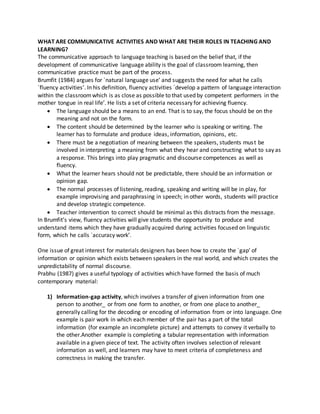
Communicative activities
- 1. WHAT ARE COMMUNICATIVE ACTIVITIES AND WHAT ARE THEIR ROLES IN TEACHING AND LEARNING? The communicative approach to language teaching is based on the belief that, if the development of communicative language ability is the goal of classroom learning, then communicative practice must be part of the process. Brumfit (1984) argues for `natural language use’ and suggests the need for what he calls `fluency activities’. In his definition, fluency activities `develop a pattern of language interaction within the classroomwhich is as close as possible to that used by competent performers in the mother tongue in real life’. He lists a set of criteria necessary for achieving fluency. The language should be a means to an end. That is to say, the focus should be on the meaning and not on the form. The content should be determined by the learner who is speaking or writing. The learner has to formulate and produce ideas, information, opinions, etc. There must be a negotiation of meaning between the speakers, students must be involved in interpreting a meaning from what they hear and constructing what to say as a response. This brings into play pragmatic and discourse competences as well as fluency. What the learner hears should not be predictable, there should be an information or opinion gap. The normal processes of listening, reading, speaking and writing will be in play, for example improvising and paraphrasing in speech; in other words, students will practice and develop strategic competence. Teacher intervention to correct should be minimal as this distracts from the message. In Brumfit’s view, fluency activities will give students the opportunity to produce and understand items which they have gradually acquired during activities focused on linguistic form, which he calls `accuracy work’. One issue of great interest for materials designers has been how to create the `gap’ of information or opinion which exists between speakers in the real world, and which creates the unpredictability of normal discourse. Prabhu (1987) gives a useful typology of activities which have formed the basis of much contemporary material: 1) Information-gap activity, which involves a transfer of given information from one person to another_ or from one form to another, or from one place to another_ generally calling for the decoding or encoding of information from or into language. One example is pair work in which each member of the pair has a part of the total information (for example an incomplete picture) and attempts to convey it verbally to the other.Another example is completing a tabular representation with information available in a given piece of text. The activity often involves selection of relevant information as well, and learners may have to meet criteria of completeness and correctness in making the transfer.
- 2. 2) Reasoning-gap activity, which involves deriving some new information from given information through processes of inference, deduction, practical reasoning, or a perception of relationships of patterns. One example is working out a teacher’s timetable on the basis of given class timetables. Another is deciding what course of action is best (for example cheapest or quickest) for a given purpose and within given constraints. The activity necessarily involves comprehending and conveying information, as an information-gap activity, but the information to be conveyed is not identical with that initially comprehended. There is a piece of reasoning which connects the two. 3) Opinion-gap activity, which involves identifying and articulating a personal preference, feeling, or attitude in response to a given situation. One example is story completion; another is taking part in the discussion of a social issue. The activity may involve using factual information and formulating arguments to justify one’s opinion, but there is no objective procedure for demonstrating outcomes as right or wrong, and no reason to expect the same outcome from different individuals or on different occasions. The fundamental issue is how learners actually use the activities they are provided with in order to acquire language, and whether different ways of exploiting activities provide different opportunities for learning. Skehan (1996), for example, has pointed out that in performing a task under time pressure, learners may place greater emphasis on communicating messages in order to complete the task quickly and may not therefore pay much attention to correctness and completeness of language form. They may use communication strategies or string lexical phrases together to express ideas. Negotiation of meaning in such tasks will provide for the development of greater strategic competence and fluency, but will not necessarily lead to more comprehensible output and the development of greater accuracy. There is a danger, in fact, that learners may develop what Skehan calls `undesirable fluency’ with the use of convenient but incorrect forms which they then make use of in other tasks. Teachers should strike the balance between accuracy and fluency. Brumfit (1984), for example, sees these as co-existing but suggests that the balance would change over time. His suggestion is that one might expect to find a preponderance of accuracy-based work early on, for beginners, but that there would be a gradual shift in emphasis as learners acquire more language and that upper-intermediate learners might be involved for a high proportion of class time in fluency work. Linguistic competence is a fundamental component of communicative language ability and it has perhaps been a misconception among teachers that the communicative approach somehow excuses teachers and learners from a consideration of how to develop high levels of accuracy in the use of grammar, pronunciation, and vocabulary. On the contrary, it is rather a question of how to develop communicative language ability through classroompractice but, at the same time, to ensure an understanding of how language works as a system and to develop an ability to use the system correctly, appropriately, and creatively. Adapted from `Teaching and Learning in the Language Classroom’ Tricia Hedge